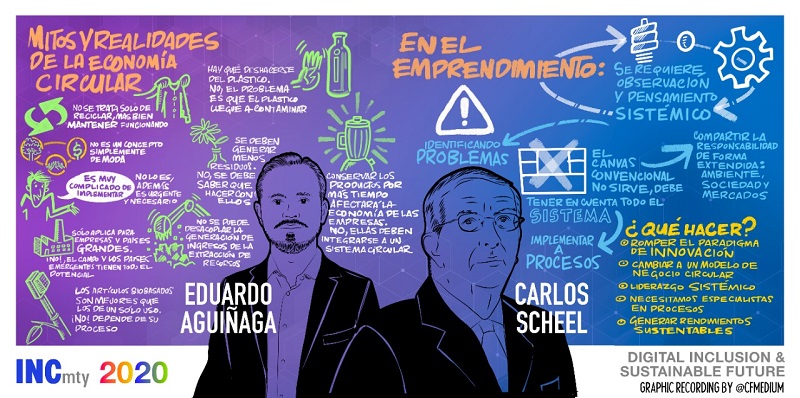During INCmty, experts urged people to "innovate innovation" by addressing the characteristics of the new circular systems entrepreneur, and the myths and realities of the Circular Economy.
By JOSÉ ÁNGEL DE LA PAZ | EGADE BUSINESS SCHOOL
As part of INCmty 2020, experts in Circular Economy from EGADE Business School clarified a number of ideas and misinterpretations related to this economic concept. They also addressed the characteristics that define the new circular systems entrepreneur.
As part of the agenda of the Sustainability Summit, Eduardo Aguiñaga, National Director of the Master in Business Management, and Carlos Scheel, Emeritus Professor, presented “Myths and realities of the Circular Economy.”
Aguiñaga emphasized that the circular economy is not just "a new and fashionable concept" that will soon cease to be relevant but, on the contrary, it is the paradigm that will prevent the world from running out of resources.
Compared to the linear economy system that basically involves "taking, using and throwing away," the circular economy is a regenerative system articulated socially, economically and environmentally to maintain the value of resources and reduce both the input of materials and the output of waste. This creates a closed loop or circle where waste is designed to be reintroduced into the production system.
Among the most common false interpretations, Aguiñaga pointed out the following:
- "The circular economy is very difficult to implement." It is not; it is also urgent and necessary.
- "The circular economy is only applied in large companies and/or developed countries." False; emerging fields and countries also have the potential.
- "Biobased, recyclable and/or multi-use items are much better than single-use products." Not necessarily; it depends on the impact of the process used to manufacture them.
- "Supporters of the circular economy postulate the absolute elimination of plastics." False; the challenge is making sure that the plastic does not pollute.
- "The circular economy focuses on generating less waste and not polluting so much." No; it focuses on thinking about what to do with the waste.
- “The decoupling between income generation and resource extraction that the circular economy seeks is practically impossible to achieve”. False; it is possible.

Scheel indicated that new circular systems entrepreneurs are different from conventional entrepreneurs, and their endeavors go beyond just setting up sustainable or "green" businesses.
To be circular systems entrepreneurs, people must:
- Break the 20th-century paradigm of linear innovation.
- Migrate from linear business models to circular systems business models.
- Move from being conventional analytical leaders to leading the creation of conditions and systems.
- Be specialists in unusual processes.
- Be systemic and circular entrepreneurs who generate sustainable wealth.
“You have to innovate the innovation of the 20th century. Why? Because the challenges are different from those of the last century. There are other priorities for the planet, its citizens and industry,” said Scheel.
For example, he observed that the innovation of electric cars does not solve the problems of mobility, road chaos, and public transport because they are not systemically designed to generate value extended to the environment, society, and markets.
“The characteristics of the new entrepreneurs are disruptive innovation, a systemic approach, a circular economy, and unusual processes. They are leaders who assemble systems,” he explained.
Scheel concluded that the objective of starting up unusual new businesses is to transform an idea related to a problem, or a linear business initiative, into a “circular business system with sustainable and extended value” that is financially profitable, has an attractive market and is designed to participate in an economy aligned to the sustainable growth of the country.